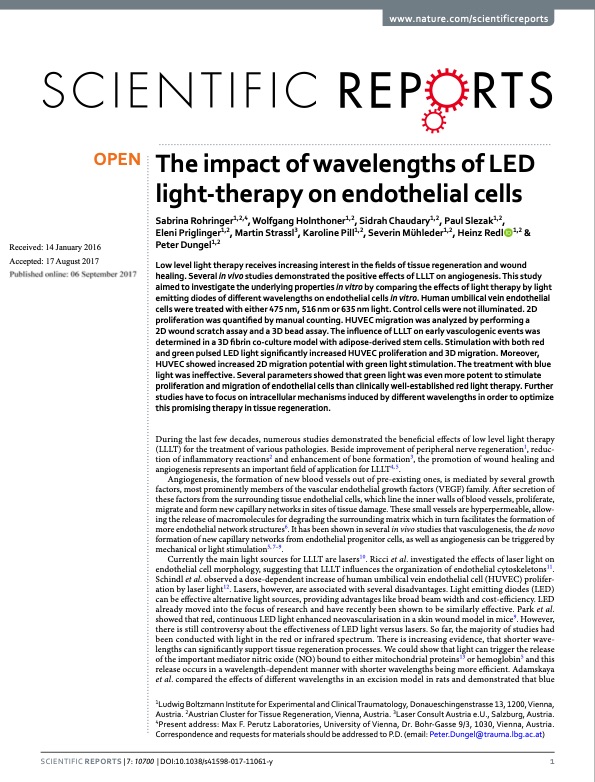
PDF Publication Title:
Text from PDF Page: 002
www.nature.com/scientificreports OPEN Received: 14 January 2016 Accepted: 17 August 2017 Published: xx xx xxxx The impact of wavelengths of LED light-therapy on endothelial cells Sabrina Rohringer1,2,4, Wolfgang Holnthoner1,2, Sidrah Chaudary1,2, Paul Slezak1,2, Eleni Priglinger1,2, Martin Strassl3, Karoline Pill1,2, Severin Mühleder1,2, Heinz Redl 1,2 & Peter Dungel1,2 Low level light therapy receives increasing interest in the fields of tissue regeneration and wound healing. Several in vivo studies demonstrated the positive effects of LLLT on angiogenesis. This study aimed to investigate the underlying properties in vitro by comparing the effects of light therapy by light emitting diodes of different wavelengths on endothelial cells in vitro. Human umbilical vein endothelial cells were treated with either 475 nm, 516 nm or 635 nm light. Control cells were not illuminated. 2D proliferation was quantified by manual counting. HUVEC migration was analyzed by performing a 2D wound scratch assay and a 3D bead assay. The influence of LLLT on early vasculogenic events was determined in a 3D fibrin co-culture model with adipose-derived stem cells. Stimulation with both red and green pulsed LED light significantly increased HUVEC proliferation and 3D migration. Moreover, HUVEC showed increased 2D migration potential with green light stimulation. The treatment with blue light was ineffective. Several parameters showed that green light was even more potent to stimulate proliferation and migration of endothelial cells than clinically well-established red light therapy. Further studies have to focus on intracellular mechanisms induced by different wavelengths in order to optimize this promising therapy in tissue regeneration. During the last few decades, numerous studies demonstrated the beneficial effects of low level light therapy (LLLT) for the treatment of various pathologies. Beside improvement of peripheral nerve regeneration1, reduc- tion of inflammatory reactions2 and enhancement of bone formation3, the promotion of wound healing and angiogenesis represents an important field of application for LLLT4, 5. Angiogenesis, the formation of new blood vessels out of pre-existing ones, is mediated by several growth factors, most prominently members of the vascular endothelial growth factors (VEGF) family. After secretion of these factors from the surrounding tissue endothelial cells, which line the inner walls of blood vessels, proliferate, migrate and form new capillary networks in sites of tissue damage. These small vessels are hyperpermeable, allow- ing the release of macromolecules for degrading the surrounding matrix which in turn facilitates the formation of more endothelial network structures6. It has been shown in several in vivo studies that vasculogenesis, the de novo formation of new capillary networks from endothelial progenitor cells, as well as angiogenesis can be triggered by mechanical or light stimulation5, 7–9. Currently the main light sources for LLLT are lasers10. Ricci et al. investigated the effects of laser light on endothelial cell morphology, suggesting that LLLT influences the organization of endothelial cytoskeletons11. Schindl et al. observed a dose-dependent increase of human umbilical vein endothelial cell (HUVEC) prolifer- ation by laser light12. Lasers, however, are associated with several disadvantages. Light emitting diodes (LED) can be effective alternative light sources, providing advantages like broad beam width and cost-efficiency. LED already moved into the focus of research and have recently been shown to be similarly effective. Park et al. showed that red, continuous LED light enhanced neovascularisation in a skin wound model in mice9. However, there is still controversy about the effectiveness of LED light versus lasers. So far, the majority of studies had been conducted with light in the red or infrared spectrum. There is increasing evidence, that shorter wave- lengths can significantly support tissue regeneration processes. We could show that light can trigger the release of the important mediator nitric oxide (NO) bound to either mitochondrial proteins13 or hemoglobin5 and this release occurs in a wavelength-dependent manner with shorter wavelengths being more efficient. Adamskaya et al. compared the effects of different wavelengths in an excision model in rats and demonstrated that blue 1Ludwig Boltzmann Institute for Experimental and Clinical Traumatology, Donaueschingenstrasse 13, 1200, Vienna, Austria. 2Austrian Cluster for Tissue Regeneration, Vienna, Austria. 3Laser Consult Austria e.U., Salzburg, Austria. 4Present address: Max F. Perutz Laboratories, University of Vienna, Dr. Bohr-Gasse 9/3, 1030, Vienna, Austria. Correspondence and requests for materials should be addressed to P.D. (email: Peter.Dungel@trauma.lbg.ac.at) SCientifiC REpORTS | 7: 10700 | DOI:10.1038/s41598-017-11061-y 1PDF Image | impact of wavelengths of LED light-therapy on endothelial cells

PDF Search Title:
impact of wavelengths of LED light-therapy on endothelial cellsOriginal File Name Searched:
Rohringeretal-LLLT2017.pdfDIY PDF Search: Google It | Yahoo | Bing
Cruise Ship Reviews | Luxury Resort | Jet | Yacht | and Travel Tech More Info
Cruising Review Topics and Articles More Info
Software based on Filemaker for the travel industry More Info
The Burgenstock Resort: Reviews on CruisingReview website... More Info
Resort Reviews: World Class resorts... More Info
The Riffelalp Resort: Reviews on CruisingReview website... More Info
| CONTACT TEL: 608-238-6001 Email: greg@cruisingreview.com | RSS | AMP |